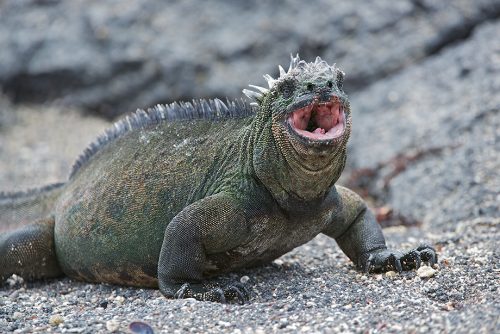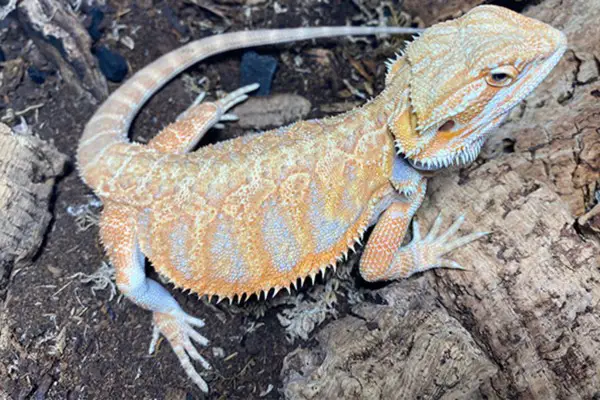The marine iguana (Amblyrhynchus cristatus) is the only truly marine lizard off the coast of Ecuador, of the Galapagos Island. The iguana is rather a strange looking creature recognized by its blunt nose and bony bumps. Unlike most other lizards marine iguanas have heavy body. They are extremely territorial in that they attack any male that may attempt to get too close.
Marine Iguana Facts
- Marine iguanas are dark grey to completely black in color but few species have some patterns of orange and red color.
- They are medium-sized lizards with the heavy body that grows to a length of about 4 feet (1.2 meters).
- There are crested spines that are seen all throughout the neck to the end of the tail.
- The weight of the marine iguanas differs significantly—they can be as large as 12 kilograms or as small as 1 kilogram. Large iguanas are found on the southern Isabela while the small species inhabit the Genovesa.
- Adult males are 70% larger than the adult females.
- Marine iguanas are only found in the Galapagos Island that is why they are also called ‘Galapagos marine iguana’.
- It has sturdy legs and partially developed webbed feet that helps the lizard to swim smoothly.
Distribution & Habitat
- Marine iguanas are mainly found on the larger islands of Galapagos Archipelago.
- They are able to live in a depth of 40 feet (12 meters). Iguanas are likely to make homes on rocky seashores, as well as occupying subtidal zones to feed on algae.
- Unlike land iguanas that feed on the leaves of pear cacti, marine lizards live in and around the sea.

Diet & Feeding Ecology
- The marine iguana is thought to feed on seaweed and other marine algae. They will consume as many as 4 to 5 species of algae.
- Preferred among the iguana’s diet is red and green algae but they mostly rely on green algae because red algae is too scarce.
- Unlike females, adult males will go for algae offshore and as such they don’t need to face any competition from young iguanas or females.
- The given temperature and the particular season determine the foraging behavior of marine iguanas.
- They might not swim if the tides are too high however once the tides go down, iguanas are likely to go into the water to feed on seaweed that are on the shores and reefs.
- Iguanas will often hold the rock rather firmly with its sharp claws—not to be disturbed by the surf. Sometimes they swim out to eat seabed.
- They eat seaweed from underwater rocks.
Behavior
- Marine iguanas typically feed at a depth of 15 ft (4.5 m) for the dive lasts as long as 15 – 20 minutes.
- They need to maintain a particular body temperature so as to remain active. During its stay in cold water, the body temperature falls very quickly. Iguanas however deal with this by slowing down the heart rate thus reducing the blood circulation to prevent heat loss.
- Once the iguana returns to the shore to bask in the sun, the body temperature becomes normal and the body warms up again.
- Iguanas release water from the nose in order to rid their body of excess salt.
- Scientists fail to understand why marine iguanas share their islands with two other land iguanas. One reason might be that marine iguanas could have evolved from land iguanas around 8 million years ago.
- Outside the breeding season, marine iguanas may gather around in close groups—often they climb on each other to bask in the sun. On the lava field during the midday iguanas find cover in crevices, under boulders, or in the shades of mangroves.
- Adult males are thought to establish small territories—so much so that one iguana may be sitting on a boulder while the other male lies at the foot of boulder.
- Marine iguanas do fight but only sometimes.
- They drive off other male iguanas by raising its body on legs while moving the head. Adult males are also involved in head-on push just to claim their territories.
- At night, they might tolerate each other on territories because during this time they conserve heat. Females and young iguanas are not territorial.
Reproductive Biology
- The breeding season of marine iguanas begin in December.
- Males will soon mark the territories in order to invite females to mate.
- After the males are gone, female iguanas might dig a 2-foot (60-inch) tunnel in the sand and are going to defend nesting sites rather actively.
- A female lays 2 – 3 white eggs in the tunnel. Later she covers the eggs with sand and camouflages the tunnel.
- Each of the eggs measures 8 by 4.5 cm.
- The eggs hatch in about 110 days. Hatching mostly occurs in May. Snakes and hawks are likely to prey on eggs and young iguanas.
- The breeding interval is one year.
- The infant iguanas weigh up to 9 inches (23 cm) at birth.
- Predators of marine iguanas include cats, dogs, sharks, herons, gulls, and Galapagos hawks.
- The total population of marine iguanas is 50,000.
Conservation Status
Vulnerable








